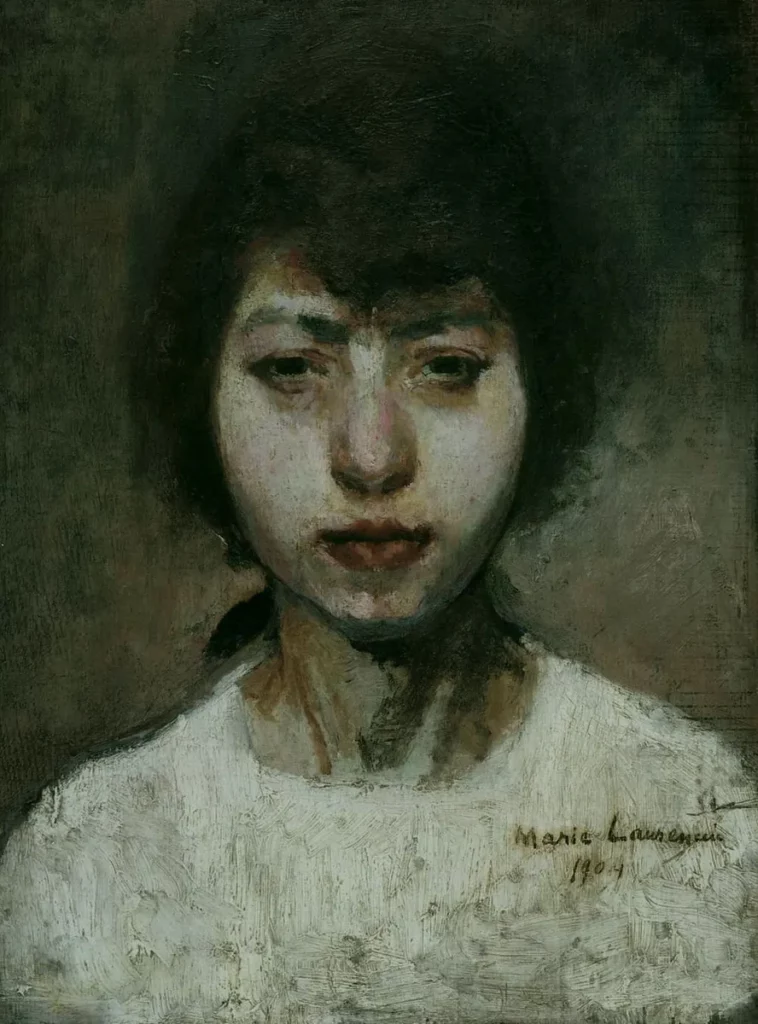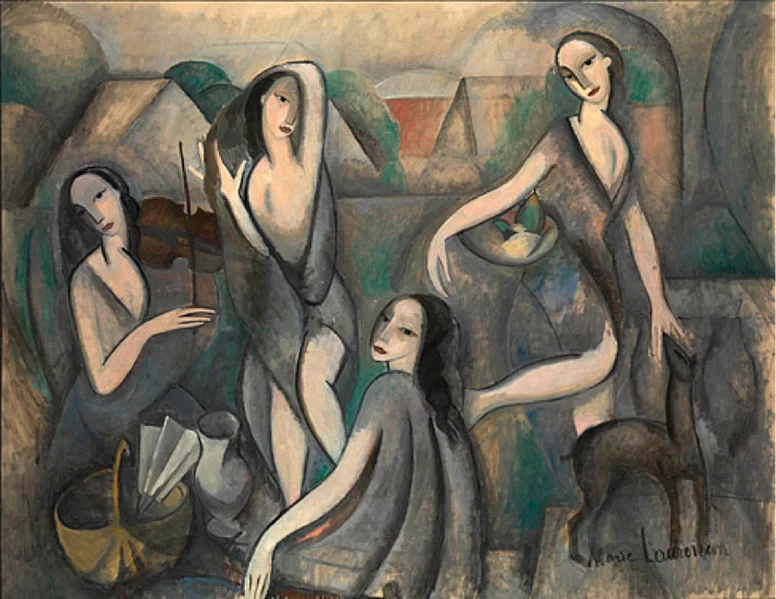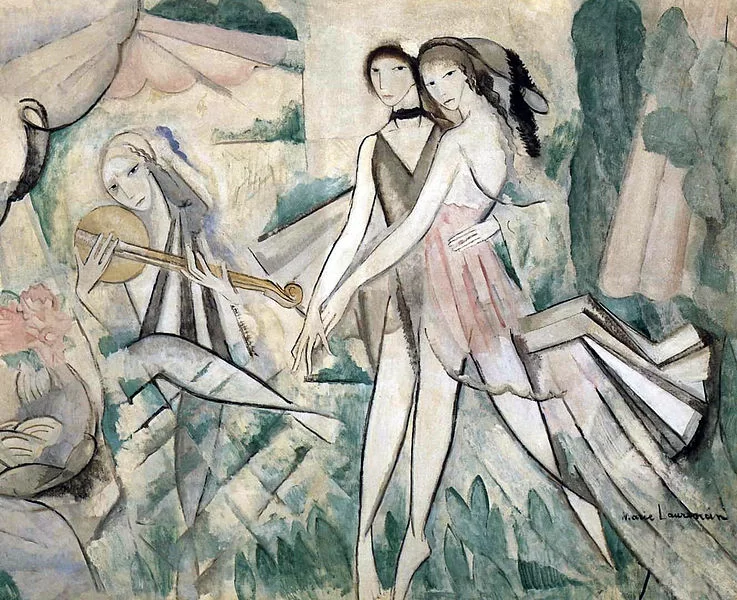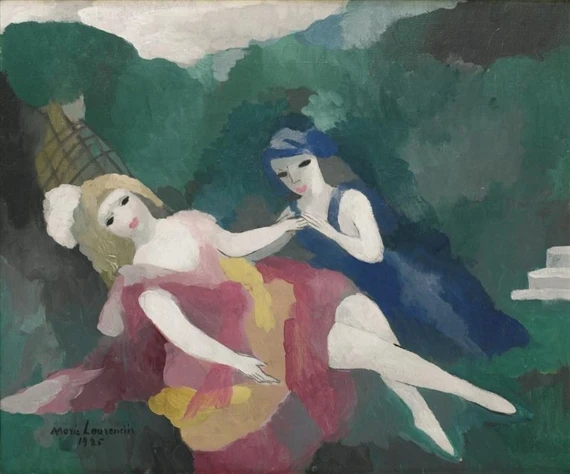When I first saw the work of Marie Laurencin I wanted to melt into each painting and become part of the ethereal intimacy she created with every composition. Was that a lot? Because this is another artist that was a lot, but in a more subtle way than artists like Tamara de Lempicka. Marie grew up under the thumb of her mother, battled depression and loneliness throughout her life, established her career among domineering men, and openly represented queerness at the turn of the 20th century. Above all, Marie was unapologetically Marie.
Marie’s Childhood
Marie Laurencin was born in Paris on October 31, 1883 to Pauline Laurencin. She was also the illegitimate child of politician Alfred Toulet. Even though he visited on occasion, she didn’t know he was her father and despised his presence. Marie didn’t learn the truth until she was 21.
It was otherwise just Marie and her mother living alone. Pauline was controlling, but distant, and had her own ideas of what her young daughter should grow up to be. Marie was well-read and began drawing at an early age, but her mother disapproved of her creative efforts. She sometimes destroyed Marie’s drawings because she wanted her to become a teacher. However, Marie was uninterested in school and did so poorly that becoming a teacher was out of the question.

This portrait makes it pretty clear how Marie felt about her mom.
Marie’s (Successful) Education
After her failures in school Marie started a series of self portraits, but they were criticized for being narcissist. This criticism followed her later into her career as the women she painted were said to all look like her. Her women also had smooth, porcelain skin – possibly in part because she studied porcelain painting at the École de Sèvres at age 18.

In 1903 Marie studied at the Académie Humbert to practice drawing, painting, and printmaking. There she learned oil painting, a skill that later helped her enter the orbit of established male artists like Pablo Picasso and Robert Delaunay. She also he met fellow artist George Braque at the Académie.
During this time, Marie began attending Natalie Barney’s “famous neo-Sapphic gatherings” where lesbian and bisexual women would socialize and talk about creativity and how it related to female desire. Being a part of this circle was a huge influence on Marie’s life and art.
Marie’s first attempted printmaking in 1904 with erotic illustrations of women. It was around this time that Marie made her own attraction to women clear.

A Queer View Among Men
In 1907, when Marie was 24, Braque introduced her to Picasso, who then introduced her to the poet Guillaume Apollinaire. They began a passionate relationship that lasted six years. His admiration for her helped to launch her career as he encouraged her to explore her own style and wrote glowing reviews of her work. Her connections with the creatives in the Parisian avant-garde movement also helped her get into some of the best shows in Paris.
This doesn’t mean that her male counterparts handed her an art career. They saw her as innocent and naive, but she was smart enough to recognize the opportunity to promote her work. While she explored Cubism at first, the further she delved into her own soft, ethereal style, the further her work stood in contrast to the stark, masculine work of artists like Picasso.


Also in 1907, Marie had her first exhibition at the Salon des Indépendants. This show was often associated with the Cubists, but she did not want to be seen as part of the Cubist movement. “Instead, she drew from the dreamlike imagery of modern poets,…and the soft colors of Impressionists such as Auguste Renoir.”
In 1911 Marie “was the only woman to have work included in the Maison Cubiste”, a show that included artists like Marcel Duchamp. The public literally attacked the exhibit and she and another artist physically guarded the show with umbrellas.

The following year, Marie showed at the Section d’Or exhibition at Paris’s Galerie Boëtie. By this time, she and Apollinaire had begun to drift apart. He was overbearing and controlling (kind of like mom!), and by now Marie had established herself as an artist. When the relationship ended in 1913, he did not handle it well and refused to acknowledge that they were no longer together.
Marie Laurencin Moves On
Marie’s mother died in 1913 around the time she ended her relationship with Apollinaire. The next year she married German painter Otto von Waëtjen, supposedly because he reminded her of her mother. It was said that he saw himself as the better artist and saw his wife as beneath him. Unsurprisingly, Marie was unhappy during this time, but at least it made Apollinaire finally accept that she had moved on.


When World War I broke out, Marie and her husband moved to Spain to escape the growing contempt for Germans and stayed there for almost five years. Marie missed Paris and lost interest in painting while in Spain. Even though she was depressed, she became involved in Dadaism and was part of the avant-garde movement in Spain. She also discovered an affinity for Francisco Goya’s work, especially the women he painted. Marie and her husband then moved to Dusseldorf in 1919. Their marriage deteriorated due to Otto’s drinking and Marie filed for divorce.
In 1920 Marie returned to Paris, refining her work into what she’s remembered for today. She enjoyed financial stability as her paintings became more popular and sold her work on her own terms, much to the chagrin of her dealer. Marie charged more for work she found boring and often gave pieces away to her friends. She charged twice as much for portraits of men and charged brunettes more than blondes. Supposedly she only painted children she liked.
Marie on Her Own
Marie had lovers over the years, but never remarried. She devoted her time to honing her craft and her energy to her closest friends. It was rumored that she had both male and female lovers and she openly associated with lesbian groups, but this was never a detriment to her reputation.
After the war Marie spent more time pursuing her own artistic ideals. She painted the pastel portraits of women we recognize today. Her work also became more erotic, “often showing women kissing and laying together” as she continued to explore her identity as a queer woman.

Amidst the masculine energy of Cubist painters she painted the intimacy and deep relationships between women with organic forms and pastel palettes. She explored her own desires and sexuality with each composition, giving her subjects control of the viewer’s gaze with eye contact. Where a male artist would make similar scenes voyeuristic, Marie challenged the viewer’s intent by acknowledging their presence.
By 1930 Marie was a popular portrait painter. In 1931 she helped found La Société des femmes artistes modernes. She taught for a few years while continuing to paint through WWII.

As she got older, Marie isolated herself more and more due to her depression and declining health, but she continued to paint. She lived with her maid, Suzanne Moreau, who she lived with since 1925. They were rumored to be romantic, but at the least were very close. Marie adopted Suzanne at age 49 in order to make her the beneficiary of her estate. She died of a heart attack on June 6, 1956 and was buried in her beloved Paris.
